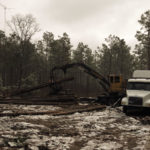
New green growth draws deer to areas that have been recently logged. Take advantage of this new food source for great hunting.
North Carolina is home to over 18 million acres of forestland, and these wooded pavilions fuel the state’s top manufacturing industries. According to the U.S. Department of Commerce, the forest-products industry is the leading manufacturing industry in the state, supplying more than 175,000 jobs and $16 billion in product shipments annually.
For hunters who target whitetail deer, interactions with a logger or logging activities is a sure thing, but hunting in areas that have recently been logged is not quite as bad as it seems. In fact, hunters should gravitate to areas of recent logging activity whenever possible to fill one of their tags.
North Carolina is known as the birthplace of sustainable forestry practices, aka, the Cradle of Forestry in America, and those practices offer a wide range of effects, from fresh clear- cuts to mature forests, and every stage of the game offers deer different opportunities to live. Savvy deer hunters can make every forestry phase work into their hunting strategy to get a trophy buck in range.
R.J. Seiler of Rockingham County is well accustomed to hunting anything from clear-cuts and selective cuts to mature forests. He pays special attention to logging activity that takes place just before or during deer season.
“Logging activity provides immediate benefits to wildlife,” Seiler said. “Food availability increases right after logging, (and) that brings more deer into the area.”
Whether selectively harvested or clear-cut, the landscape changes abruptly when the monstrous tractors and heavy duty machines used for cutting and transporting timber move in. As soon as the forests are disturbed, sunlight penetrates through the canopy to the freshly-exposed soil. An explosion of green growth occurs, with a tsunami of tender forbs and sprouts showing up everywhere. Deer flock to these areas to feed on these new food sources.
“Clear-cuts provide the best foraging opportunities for the first three years of its life in most cases. After that, they become good cover and select bedding areas,” he said.
Seiler loves to watch a fresh clear-cut during the rut.
“In the rut, lots of does come in to feed in the clear-cut. You can see well enough to cover lots of area and catch a buck cruising or chasing a hot doe,” he said.
Visibility increases immediately after a stand is clear-cut, and that gives hunters a real advantage, especially during the rut when bucks are running all over creation to find a suitor.
To make the most out of a clear-cut hunt, hunters must be equipped with three important strategies. First, height has its advantages. Tree stands erected in tall trees along the edge of the clear-cut allow hunters to cover a large area effectively. Higher vantage points almost always improve a hunter’s chance of encountering a deer at a distance.
Sharp optics are critical gear, including both a crisp rifle scope and binoculars with a wide field of view. Hunters need to be able to scan the horizon and pick out anything that moves or that resembles a deer. Precision optics gives hunters a true advantage when hunting in places where the view seems endless.
Third, hunters need to be alert from the time they get into the stand until the time they climb down. Deer are not on a set schedule during the rut, and noon can be just as productive as dawn. As a clear-cut area ages, deer can slip in and out without being noticed. Hunters need to be alerts to get the most out of the hunt in these areas.
While clear-cuts provide excellent hunting throughout the season, recent selective harvests or thinnings are also great places. Many of the same principles can be applied in selectively harvested areas because there are plenty of disturbances, with many tender sprouts available for forage. Visibility will increase as well, but not as much as in the clear-cut areas. However, the residual trees will give deer a better sense of security over the barren, clear-cut sites that have little to no cover available.
Whether because of an increase in food availability or another reason, deer flock to recently harvested tracts, and it doesn’t take long for the deer to show up on the scene, either. Quite often, deer will pay very little attention to the logging equipment during the active operation.
For deer hunters in North Carolina, timber harvesting is something that will impact just about every tract of land available, whether public, private or industry-owned land. Logging and forestry practices shape the landscape every day and provide both hunters and wildlife opportunities. And for hunters looking for a good buck to take to the Dixie Deer Classic in Raleigh this year, recently logged sites are good places to spend the day in a tree stand.






Be the first to comment